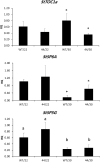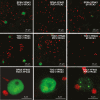Identification of TIMING OF CAB EXPRESSION 1 as a temperature-sensitive negative regulator of tuberization in potato
- PMID: 31328229
- PMCID: PMC6812706
- DOI: 10.1093/jxb/erz336
Identification of TIMING OF CAB EXPRESSION 1 as a temperature-sensitive negative regulator of tuberization in potato
Abstract
For many potato cultivars, tuber yield is optimal at average daytime temperatures in the range 14-22 °C. Above this range, tuber yield is reduced for most cultivars. We previously reported that moderately elevated temperature increases steady-state expression of the core circadian clock gene TIMING OF CAB EXPRESSION 1 (StTOC1) in developing tubers, whereas expression of the StSP6A tuberization signal is reduced, along with tuber yield. In this study we provide evidence that StTOC1 links environmental signalling with potato tuberization by suppressing StSP6A autoactivation in the stolons. We show that transgenic lines silenced in StTOC1 expression exhibit enhanced StSP6A transcript levels and changes in gene expression in developing tubers that are indicative of an elevated sink strength. Nodal cuttings of StTOC1 antisense lines displayed increased tuber yields at moderately elevated temperatures, whereas tuber yield and StSP6A expression were reduced in StTOC1 overexpressor lines. Here we identify a number of StTOC1 binding partners and demonstrate that suppression of StSP6A expression is independent of StTOC1 complex formation with the potato homolog StPIF3. Down-regulation of StTOC1 thus provides a strategy to mitigate the effects of elevated temperature on tuber yield.
Keywords: Circadian clock; StSP6A; TIMING OF CAB EXPRESSION 1; environment; heat stress; potato; tuberization.
© The Author(s) 2019. Published by Oxford University Press on behalf of the Society for Experimental Biology.
Figures







Similar articles
-
The physiological and molecular responses of potato tuberization to projected future elevated temperatures.Plant Physiol. 2024 Dec 24;197(1):kiae664. doi: 10.1093/plphys/kiae664. Plant Physiol. 2024. PMID: 39688842 Free PMC article.
-
Potato Tuber Induction is Regulated by Interactions Between Components of a Tuberigen Complex.Plant Cell Physiol. 2017 Feb 1;58(2):365-374. doi: 10.1093/pcp/pcw197. Plant Cell Physiol. 2017. PMID: 28028166
-
Potato CONSTANS is involved in photoperiodic tuberization in a graft-transmissible manner.Plant J. 2012 May;70(4):678-90. doi: 10.1111/j.1365-313X.2012.04909.x. Epub 2012 Mar 5. Plant J. 2012. PMID: 22260207
-
Key players associated with tuberization in potato: potential candidates for genetic engineering.Crit Rev Biotechnol. 2017 Nov;37(7):942-957. doi: 10.1080/07388551.2016.1274876. Epub 2017 Jan 18. Crit Rev Biotechnol. 2017. PMID: 28095718 Review.
-
Molecular signals that govern tuber development in potato.Int J Dev Biol. 2020;64(1-2-3):133-140. doi: 10.1387/ijdb.190132ab. Int J Dev Biol. 2020. PMID: 32659001 Review.
Cited by
-
PEBP Signaling Network in Tubers and Tuberous Root Crops.Plants (Basel). 2023 Jan 6;12(2):264. doi: 10.3390/plants12020264. Plants (Basel). 2023. PMID: 36678976 Free PMC article. Review.
-
The physiological and molecular responses of potato tuberization to projected future elevated temperatures.Plant Physiol. 2024 Dec 24;197(1):kiae664. doi: 10.1093/plphys/kiae664. Plant Physiol. 2024. PMID: 39688842 Free PMC article.
-
Construction of heat stress regulation networks based on Illumina and SMRT sequencing data in potato.Front Plant Sci. 2023 Nov 2;14:1271084. doi: 10.3389/fpls.2023.1271084. eCollection 2023. Front Plant Sci. 2023. PMID: 38023929 Free PMC article.
-
Comparative transcriptome analysis of genes related to tuberization in late and early maturing potato (Solanum tuberosum) cultivars.Sci Rep. 2025 Jul 17;15(1):26000. doi: 10.1038/s41598-025-11875-1. Sci Rep. 2025. PMID: 40676087 Free PMC article.
-
Functional Modules in the Meristems: "Tinkering" in Action.Plants (Basel). 2023 Oct 23;12(20):3661. doi: 10.3390/plants12203661. Plants (Basel). 2023. PMID: 37896124 Free PMC article. Review.
References
-
- Abelenda JA, Cruz-Oró E, Franco-Zorrilla JM, Prat S. 2016. Potato StCONSTANS-like1 suppresses storage organ formation by directly activating the FT-like StSP5G repressor. Current Biology 26, 872–881. - PubMed
-
- Abelenda JA, Navarro C, Prat S. 2011. From the model to the crop: genes controlling tuber formation in potato. Current Opinion in Biotechnology 22, 287–292. - PubMed
-
- Birch PR, Bryan G, Fenton B, Gilroy EM, Hein I, Jones JT, Prashar A, Taylor MA, Torrance L, Toth IK. 2012. Crops that feed the world 8: potato: are the trends of increased global production sustainable? Food Security 4, 477–508.
Publication types
MeSH terms
Substances
LinkOut - more resources
Full Text Sources
Research Materials

